Cellular Jail
The Cellular Jail, also known as Kālā Pānī (Hindi for black waters), was a colonial prison in the Andaman and Nicobar Islands, India. The prison was used by the British for the express purpose of exiling political prisoners to the remote archipelago. Many notable independence activists, including Batukeshwar Dutt, Yogendra Shukla and Vinayak Damodar Savarkar, were imprisoned here during the struggle for India's independence. Today, the complex serves as a national memorial monument.[2]
| Cellular Jail (Kālā Pānī) | |
|---|---|
Entrance to Cellular Jail | |

| |
| General information | |
| Type | Prison for political prisoners (Indian independence activists) |
| Architectural style | Cellular, pronged |
| Town or city | Port Blair, Andaman |
| Country | India |
| Coordinates | 11.675°N 92.748°E |
| Construction started | 1896 |
| Completed | 1906 |
| Cost | ₹517,352[1] |
| Client | British Raj |
| Owner | Government of India |
History
Although the prison complex itself was constructed between 1896 and 1906, the British had been using the Andaman Islands as a prison since the days in the immediate aftermath of the revolt of 1857.
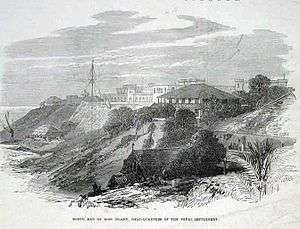
Shortly after the rebellion was suppressed, the British executed many rebels. Those who survived were exiled for life to the Andamans to prevent their re-offending. Two hundred rebels were transported to the islands under the custody of the jailer David Barry and Major James Pattison Walker, a military doctor who had been warden of the prison at Agra. Another 733 from Karachi arrived in April, 1868.[3] In 1863, the Rev. Henry Fisher Corbyn, of the Bengal Ecclesiastical Establishment, was also sent out there and he set up the 'Andamanese Home' there, which was also a repressive institution albeit disguised as a charitable one.[4] Rev. Corbyn was posted in 1866 as Vicar to St. Luke's Church, Abbottabad, and later died there and is buried at the Old Christian Cemetery, Abbottabad. More prisoners arrived from India and Burma as the settlement grew.[5] Anyone who belonged to the Mughal royal family, or who had sent a petition to Bahadur Shah Zafar during the Rebellion was liable to be deported to the islands.
The remote islands were considered to be a suitable place to punish the independence activists. Not only were they isolated from the mainland, the overseas journey (kala pani) to the islands also threatened them with loss of caste, resulting in social exclusion.[6] The convicts could also be used in chain gangs to construct prisons, buildings and harbour facilities. Many died in this enterprise. They served to colonise the island for the British.
By the late 19th century the independence movement had picked up momentum. As a result, the number of prisoners being sent to the Andamans grew and the need for a high-security prison was felt. From August 1889 Charles James Lyall served as home secretary in the Raj government, and was also tasked with an investigation of the penal settlement at Port Blair.[7][8] He and A. S. Lethbridge, a surgeon in the British administration, concluded that the punishment of transportation to the Andaman Islands was failing to achieve the purpose intended and that indeed criminals preferred to go there rather than be incarcerated in Indian jails. Lyall and Lethbridge recommended that a "penal stage" should exist in the transportation sentence, whereby transported prisoners were subjected to a period of harsh treatment upon arrival. The outcome was the construction of the Cellular Jail, which has been described as "a place of exclusion and isolation within a more broadly constituted remote penal space."[9]
Architecture
The construction of the prison started in 1896 and was completed in 1906. The original building was a puce-coloured brick building. The bricks used to build the building were brought from Burma.
The building had seven wings, at the centre of which a tower served as the intersection and was used by guards to keep watch on the inmates; this format was based on Jeremy Bentham's idea of the Panopticon. The wings radiated from the tower in straight lines, much like the spokes of a bicycle wheel.
Each of the seven wings had three stories upon completion. There were no dormitories and a total of 696 cells. Each cell was 4.5 by 2.7 metres (14.8 ft × 8.9 ft) in size with a ventilator located at a height of 3 metres (9.8 ft).[10] The name, "cellular jail", derived from the solitary cells which prevented any prisoner from communicating with any other. Also, the spokes were so designed such that the face of a cell in a spoke saw the back of cells in another spoke. This way, communication between prisoners was impossible. They were all in solitary confinement.[11] The locks of the prison cells were designed in such a way that the inmate would never we able to reach the latch of the lock. The prison gaurds would lock up the inmates and throw the key of the lock inside the jail. The inmate would try to put his hand out and try to unlock the door but would never be able to do so as his hand would never reach the lock.
Inmates
"The British Raj sent Indian dissidents and mutineers to a remote island penal colony in an 'experiment' that involved torture, medical tests, forced labour and, for many, death."[12] It is estimated that of the total 80,000 political prisoners, the British Raj held at the Kalapani, a very few survived.
Solitary confinement was implemented as the British government desired to ensure that political prisoners and revolutionaries be isolated from one another. The Andaman island served as the ideal setting for the government to achieve this.
Most prisoners of the Cellular Jail were independence activists. Some inmates were Fazl-e-Haq Khairabadi, Yogendra Shukla, Batukeshwar Dutt, Babarao Savarkar, Vinayak Damodar Savarkar, Sachindra Nath Sanyal, Bhai Parmanand, Sohan Singh, Subodh Roy and Trailokyanath Chakravarty[13] Several revolutionaries were tried in the Alipore Case (1908), such as Barindra Kumar Ghose, the surviving companion of Bagha Jatin, was transferred to Berhampore Jail in Bengal, before his mysterious death in 1924. The Savarkar brothers, Babarao and Vinayak, did not know that they were in different cells in the same jail for two years.
In March 1868, 238 prisoners tried to escape. By April they were all caught. One committed suicide and of the remainder Superintendent Walker ordered 87 to be hanged.[14]
Among the records of the Government of India's Home Department, we found the Empire's response in its Orders to Provincial Governors and Chief Commissioners. "Very Secret: Regarding security prisoners who hunger strike, every effort should be made to prevent the incidents from being reported, no concessions to be given to the prisoners who must be kept alive. Manual methods of restraint are best, then mechanical when the patient resists."[12]
Hunger strikes by the inmates in May 1933 caught the attention of the jail authorities. Thirty-three prisoners protested their treatment and sat in hunger strike. Among them were Mahavir Singh, an associate of Bhagat Singh (Lahore conspiracy case), Mohan Kishore Namadas (convicted in Arms Act Case) and Mohit Moitra (also convicted in Arms Act Case). These three died due to force-feeding.[15][16]

Other prisoners:[12]
- Prisoner 31552 Ullaskar Dutt (made home-made bombs that exploded inside a carriage in Muzaffarpur, killing the bridge partners of Douglas Kingsford, the chief presidency magistrate, Mrs. Pringle Kennedy and her daughter, Grace). He was tortured, declared insane due to malarial infection, transferred to the island's lunatic ward at Haddo, and held there for 14 years.
- Prisoner 31549 Barin Ghose
- Prisoner 31555, Indu Bhushan Roy (hanged himself with a strand of torn kurta, "exhausted by the unrelenting oil mill")
- Prisoner 38360, Chattar Singh, who was suspended in an iron suit for three years
- Prisoner 38511, Baba Bhan Singh, who had been beaten to death by David Barry's men
- Prisoner 41054, Ram Raksha, who had starved himself in protest at the removal of sacred Brahminical threads from around his chest
- Haripada Chowdhury (carrying two pistols when he was caught after a post office hold-up)
- Prisoner 147 Dhirendra Chowdhury (robbery to raise funds for bombs and guns), one of the few survivors of Kalapani
- Naringun Singh (guilty of desertion at Nuddea) (hanged himself in his cell, due to torture)
- Prisoner 15557 Sher Ali, killed Lord Mayo, the Viceroy of India, who arrived at the Andaman Islands on an inspection tour on February 8, 1872; hanged on March 11, 1872
- Prisoner 12819, Mehtab, and
- Prisoner 10817, Choitun, came the closest to succeeding. They stole away from the islands on March 26, 1872, rowing out into the Bay of Bengal on home-made rafts across a 750-mile stretch of turbulent water, dodging schools of bounty hunters who fought over 250-rupee rewards (then £25). Picked up by a British vessel, they persuaded the crew that they were shipwrecked fishermen and eventually pitched up, free, at the Strangers Home for Asiatics in London. The two were fed, clothed and given a bed. But while they slept, Colonel Hughes, the home's proprietor, took photographs that were circulated around the Empire. One morning, Mehtab and Choitun awoke to find themselves shackled and frog-marched aboard a ship bound for India.[12]
- Prisoner 68 Mahavir Singh: "It took a while for the whisper to reach the Yard Five Wing. By then it was 8 pm." The bell rang again. Every prisoner shuffled to his locked gate. "The feeding tube had gone into Mahavir Singh's lungs. They were filled with milk. Doctors were now fighting to revive him. So we shouted 'Inquilab Zindabad' – long live the revolution. 'Inquilab Zindabad'. Twenty-one warders ran out of the Central Tower. 'Inquilab Zindabad'. Truncheons were drawn, a gun was cocked." "Midnight", Dr. Edge noted in the penal colony's hospital log. "Mahavir Singh – dead."[12]
- Prisoner 89, Mohan Kishore, had also been killed. Drowned in milk
- Prisoner 93 Mohit Mitra, killed. Drowned in milk
- Prisoner 61, Narain (having excited sedition in the cantonment at Dinapore) was the first to try to escape. He was fished from the black water, hauled up before Dr Walker and executed.[12]
Mahatma Gandhi and Rabindranath Tagore then intervened. The government decided to repatriate the political prisoners from the Cellular Jail in 1937–38.[1] "The Cellular Jail was forced to empty in 1939. Two years later, the Japanese seized the islands, transforming the penal settlement into a prisoner of war camp, incarcerating the British warders. In 1945 the Andamans would become the first piece of India to be declared independent."[12]
INA occupation
The Empire of Japan invaded the Andaman islands in March 1942 capturing the small British garrison. The Cellular Jail then became home to British, suspected British India supporters, and later of members of the Indian Independence League, many of whom were tortured and killed there.[17] Notionally during this period control of the Islands was passed to Subhas Chandra Bose, who hoisted the Indian National Flag for the first time on the islands, at the Gymkhana Ground in Port Blair, appointed INA General AD Loganathan as the governor of the Islands, and announced the Azad Hind Government was not merely a Government in Exile, and had freed the territory from the British rule.[18]
On 7 October 1945 the British resumed control of the Islands, and prison, following the surrender of the islands to Brigadier J. A. Salomons, of the 116th Indian Infantry Brigade, a month after the Surrender of Japan, at the end of World War II.
Post Independence
Another two wings of the jail were demolished after India achieved independence. However, this led to protests from several former prisoners and political leaders who saw it as a way of erasing the tangible evidence of their history.
The Govind Ballabh Pant Hospital was set up in the premises of the Cellular Jail in 1963. It is now a 500-bed hospital with about 40 doctors serving the local population.[19]
The centenary of the jail's completion was marked on 10 March 2006. Many former prisoners were celebrated on this occasion by the Government of India.[20]
Apart from guided tours, a sound-and-light show is also run in the evenings narrating and showcasing the trials and tribulations of the inmates. It is available in English and Hindi.[21]
In Popular Culture
Kaalapani, a Malayalam film was based on the prison and its inmates during 1915. Some scenes were shot in the actual prison.
Gallery
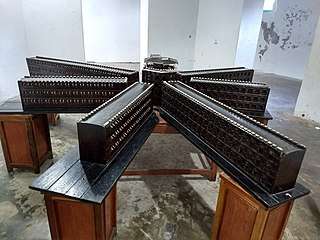 Exhibit at Cellular Jail: model of the facility
Exhibit at Cellular Jail: model of the facility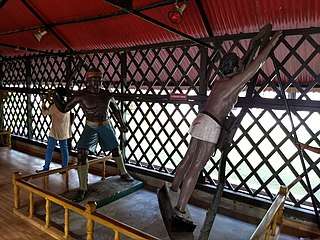 Exhibit at Cellular Jail: flogging frame
Exhibit at Cellular Jail: flogging frame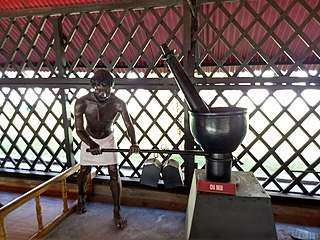 Exhibit at Cellular Jail: oil mill
Exhibit at Cellular Jail: oil mill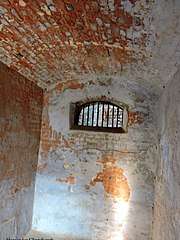 Inner view of a cell
Inner view of a cell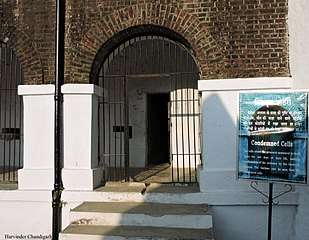 Special condemned cell for keeping prisoners before hanging
Special condemned cell for keeping prisoners before hanging- The hanging cell, where three prisoners were hanged at once
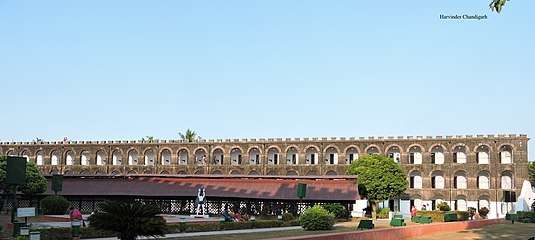 Exterior view of one wing
Exterior view of one wing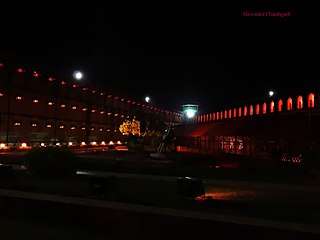 Nighttime view
Nighttime view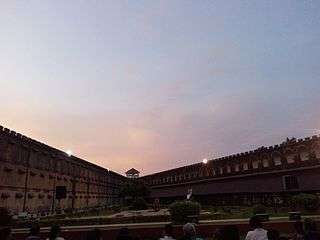 Cellular Jail shining in the sunset
Cellular Jail shining in the sunset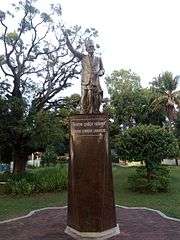 Statue of Vinayak Damodar Savarkar, a famous inmate of Kalapani
Statue of Vinayak Damodar Savarkar, a famous inmate of Kalapani
See also
- Charles Tegart, British police commissioner
- Communist Consolidation
- Kala Pani, a 1996 Indian film set in the jail
References
- "A memorial to the freedom fighters". The Hindu. India. 15 August 2004. Archived from the original on 23 October 2007. Retrieved 2 September 2006.
- History of Andaman Cellular Jail: Recapture of Andaman Islands to keep Political Prisoners Archived 18 January 2007 at the Wayback Machine. AndamanCellularJail.org. Retrieved 6 August 2010.
- "History of Andaman Cellular Jail". This is about Andaman Cellular Jail. Archived from the original on 18 January 2007.
- George Weber, Pioneer Biographies of the British Period to 1947, np, nd, Appendix A
- "Hundred years of the Andamans Cellular Jail". Andaman and Nicobar Administration website. Archived from the original on 30 September 2007. Retrieved 2 September 2006. Source: The Hindu, 21 December 2005.
- Alison Bashford; Carolyn Strange (12 November 2012). Isolation: Places and Practices of Exclusion. Psychology Press. p. 37. ISBN 978-0-415-30980-6. Retrieved 2 February 2013.
- "Lyall, Sir Charles James". Oxford Dictionary of National Biography (online ed.). Oxford University Press. doi:10.1093/ref:odnb/34642. (Subscription or UK public library membership required.)
- The India List and Office List. India Office. 1905. p. 552. Retrieved 21 November 2011.
- Strange, Carolyn; Bashford, Alison (2003). Isolation: places and practices of exclusion. London: Routledge. pp. 41–42. ISBN 978-0-415-30980-6. Retrieved 22 November 2011.
- "Cellular Jail - Darkness At Noon". MapsofIndia.com. Archived from the original on 1 November 2006. Retrieved 2 September 2006.
- "India Image: Cellular Jail". Andaman and Nicobar Administration website. Archived from the original on 24 May 2006. Retrieved 2 September 2006.
- Scott-Clark, Cathy; Levy, Adrian (22 June 2001). "Survivors of our hell". The Guardian. Retrieved 7 February 2019.
- Freedom Fighters Deported to Andamans Archived 2010-09-06 at the Wayback Machine. AndamanCellularJail.org.
- History of Andaman Cellular Jail: Atrocities committed on early freedom fighters Archived 18 January 2007 at the Wayback Machine. AndamanCellularJail.org.
- Murthy, R. V. R. (2011). Andaman and Nicobar Islands: A Saga of Freedom Struggle. Kalpaz Publications. ISBN 978-8178359038.
- Sinha, Srirajyam (1993). Bejoy Kumar Sinha: A Revolutionary's Quest for Sacrifice. Bharatiya Vidya Bhavan.
- N. Iqbal Singh The Andaman Story (Delhi: Vikas Publ.) 1978 p. 249
- Abraham, Bobins (30 December 2017). "This Day In 1943 Netaji Subhash Chandra Bose Hoisted First Independent Indian Flag In Andaman & Nicobar". The Times of India. Times of India. Retrieved 11 September 2018.
- "Dedication of INSAT- 3C/ Inauguration of Andaman & Nicobar Islands Tele-medicine Project (G B Pant Hospital)" (Press release). Indian Space Research Organization. Archived from the original on 29 February 2004. Retrieved 3 September 2006.
- "Cellular Jail completes 100 years". Andaman & Nicobar Administration website. Archived from the original on 28 May 2006. Retrieved 2 September 2006.
- "Prisons of freedom". Deccan Herald. 20 August 2019. Retrieved 13 April 2020.
External links
| Wikimedia Commons has media related to Cellular Jail. |